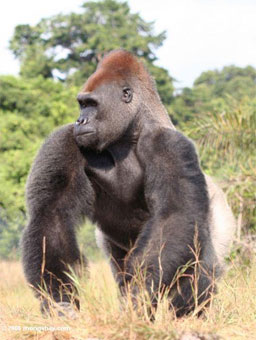Carbon traders, not conservationists, could save Cameroon rainforest
Carbon traders, not conservationists, could save Cameroon rainforest
Rhett A. Butler, mongabay.com
February 15, 2008
|
|
The government of Cameroon is looking to lease 830,000 hectares of biodiverse tropical forest to conservationists for an annual sum of $1.6 million. The problem? No conservation groups are interested. Apparently the asking price is too high, according to The Economist.
Ngoyla-Mintom forest, as the concession is known, borders the Republic of Congo and serves as a corridor of habitat between three national parks in Cameroon, Gabon and Republic of Congo. Ngoyla-Mintom is home to forest creatures including elephants and gorillas.
Without offers to meet its asking price, Cameroonian minister of forestry Joseph Matta says that he has little choice but to auction to the land to loggers.
As The Economist puts it, “Ngoyla-Mintom is thus turning into an interesting test of what the conservation market will bear.”
 Gorilla in neighboring Gabon |
One possibility is that carbon traders will see the value of carbon stored in the vegetation of Ngoyla-Mintom and conclude that it is worth protecting for the stream of offsets if could generate under Reducing Deforestation and Degradation (REDD), a nascent mechanism for fighting climate change by protecting tropical forests. While REDD is only in its earliest incarnation, there are signs that it is progressing. Last week Aceh province in Indonesia signed the first official REDD deal and the World Bank has committed US$300 million to its newly created Forest Carbon Partnership Facility, a scheme that will offer tropical countries carbon offset credits to preserve forests.
A conservative look at Ngoyla-Mintom shows that its 830,000 hectares of forest store upwards of 200 million tons of carbon dioxide (assuming 250 tons of carbon dioxide per hectare — actual values may exceed 1100). Should Ngoyla-Mintom qualify for REDD, the forest protection scheme would seem likely to offer competitive returns relative to logging.
-
The REDD calculations
Between 2000 and 2005 Cameroon lost an average of 1 percent of its forest cover each year. For calculating the potential revenue generated from REDD, this figure is applied to the 830,000 ha of Ngoyla-Mintom forest cover, amounting to a forecast annual loss of 8,300 ha.
Assuming emissions of 160 tons of carbon per hectare from logging, at $3 per ton of CO2, REDD would generate credits worth $64 million (net present value over 30 years using a 5 percent discount rate), well in excess of the $26 million in concession fees (NPV over 30 years at a 5 percent discount rate). The $38 million difference seems likely to more than make up the opportunity costs of forgoing the jobs and local development from timber harvesting.
These calculations err on the side of caution. Carbon emissions from the logging or deforestation of Ngoyla-Mintom would likely be considerably higher than the figures used, especially if the land was later converted for agriculture. Further, REDD credits are presently higher than $3 and European ETS credits currently trade for more than $30 per ton. Even so, the current model suggests that at a price point of $1.21, REDD credits would break-even with revenue from logging concessions.
Carbon traders, not conservationists, could become the saviors of Ngoyla-Mintom forest.
The price of conservation: The unkindest cut. Feb 14th 2008. From The Economist print edition